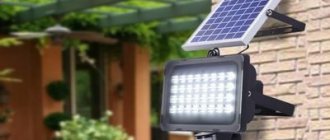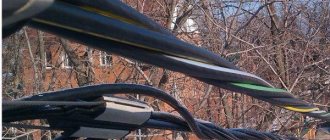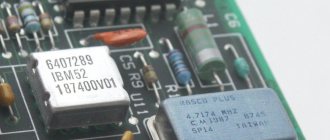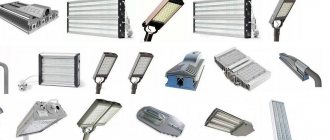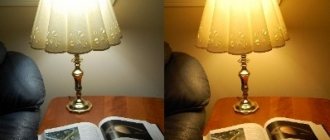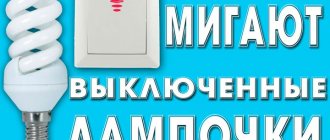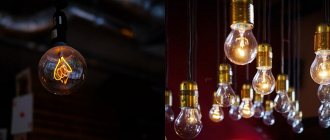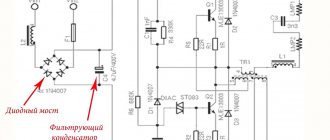LED spotlight
Until recently, LED spotlights were quite expensive. Not everyone could afford to buy them. Technologies do not stand still. LEDs are improving, drivers are becoming cheaper, etc. and so on. Accordingly, the final product becomes an order of magnitude cheaper than its predecessors.
The main purpose of any spotlight is to illuminate large spaces. And it doesn’t matter what it is - architectural structures or territory. Compared to other light sources - DNAT, DRI or DRL, the payback of LED spotlights is quite fast.
The power of LED floodlights varies greatly and can be from 10, 20, 30 W to especially powerful ones - 50, 100 W or more. Most spotlights are produced with a color temperature of at least 6500 K. This is understandable. We do not install such a light source in the apartment. We install it outdoors, and accordingly we want to get bright, “strong” light. It is this temperature that will give us the highest luminous flux, compared to 2700, 3000 K or 4500 K.
—> —>
In general, the design of any LED spotlight is practically no different from each other and does not depend on the installation location: be it a 220V, 110V spotlight with a power of 50 or 10 W (100W), street or industrial.
LEDs in LED spotlights
From the name of the light sources themselves it is clear that LEDs should be considered one of the main components) Oil). The following types of LEDs remain the most popular:
- high-power LEDs 350 mA (1,3,5 W)
- heavy-duty diodes based on COB technology (for me, these are the most preferable)
- SMD LEDs
About the main advantages, disadvantages, structure, etc. you can read in this material. Below I will only focus on the main differences between these types of diodes. All other information can be read at the link above.
Is it worth doing it yourself: all the pros and cons
Assembling a homemade spotlight is one of the leisure options, an opportunity to show your design and technical abilities. This is the main argument in favor of self-manufacturing of such devices. It must be recognized that most people do not have the proper skills in electrical engineering or do not have the necessary tools and materials.
As a result, it turns out that all the components will have to be purchased and it’s easier to just buy a spotlight. However, people for whom technical creativity is the best way to spend their time find great pleasure in such activities.
Such activities can be called ordinary entertainment, but the result is a necessary and useful device.
Features of the device of powerful 1,3,5 W LEDs for floodlights
Visually, you will not be able to tell the difference between powerful 1,3,5 W diodes, unless, of course, you are a “super professional”. The difference can only be determined by the intensity of the light. And then, not always. There may be some pitfalls. If you have a special tool, you can determine how powerful the diode is by comparing the dimensions of the crystal itself. But not everyone has such devices. And in everyday life they are not really needed.
In the photo you can see that the production of these types of diodes is quite complex. And this leads to higher prices for the latter.
By and large, powerful 1,3,5 W diodes are already outdated. If we take into account the use in LED spotlights. To obtain more or less high-quality light characteristics of diodes, you need a large number. And this is far from the best option from a pricing standpoint. I have been observing for a long time how most sellers are trying to “at least” sell their goods somewhere.
But there are also advantages to such LEDs - thermal heating. It is quite easy to handle compared to other types of chips.
Required tools and materials
To connect the lamp you will need the usual electrical tools:
- wire cutters for cutting power cables;
- installer's knife for stripping cable sections;
- a screwdriver for connecting the wire ends to the terminals.
Electrical wire cutters.
This is enough to make the connection. But a professional would also advise:
- special insulation stripper;
- lugs for wires of the appropriate diameter and crimping tool.
If the installation is carried out with multi-core wire, it is a good idea to tin the stripped areas - a soldering iron is useful for this.
And, of course, you need an electrical cable of the appropriate cross-section. For a voltage of 220 V, it can be selected from the table in accordance with the power of the spotlight:
| Conductor cross-section, sq. mm | 1 | 1,5 | 2,5 | 4 |
| Load power for copper conductor, W | 3000 | 3300 | 4600 | 5900 |
| Load power for aluminum conductor, W | — | — | 3500 | 4600 |
Important! When choosing a cable, you must take into account the power consumption of the lamp, and not the equivalent power (corresponding to the power of an incandescent lamp).
Heavy Duty COB LEDs for Floodlights
And this is not only because of the cheapness of the chips, but also mostly because you can easily “stuff” several crystals into one such diode and get 10, 20, 30, 50 watts or more. Up to 500 W! There are already such diodes. I didn’t “torture” them, but I think there must be terrible problems with the heat sink. Structurally, SOB diodes also have big differences. From round, oval, to rectangular and square. From 9 to several dozen crystals are placed in one case and filled with phosphor.
High-quality LED spotlights differ from cheap ones because they have good chips. On good ones, the board consists of a copper alloy or materials with increased thermal conductivity. This makes it possible to obtain up to 0.5 K/W. This allows for efficient heat dissipation. Floodlights with a power of 10, 20, 30 and 50 W have become very popular using COB diodes.
Photo of Navigator floodlight, 50 W
And finally - the Navigator floodlight with a power of 50 W.
LED floodlight Navigator, 50 W. Front view with glass removed
Please note that instead of a matrix, a plate with discrete (single) LEDs soldered on it is used.
Once, at the dawn of such spotlights, I tried to replace a couple of such diodes in an array. It didn’t help - some burned out, others shone very dimly. Because the parameters must be strictly the same!
LED floodlight Navigator, 50 W. LEDs – 90 discrete diodes
In theory, the power of each is a little more than 0.5 W.
LED floodlight Navigator, 50 W. Driver. GT503F board
LED floodlight Navigator, 50 W. Driver. View from the soldering side
LED floodlight Navigator, 50 W. Driver. Chip – MT 7930
Continued – how to repair LED spotlights >>>
I also recommend an interesting video on the construction of a spotlight from my colleague Dmitry:
That's all for today, good luck everyone!
Ultra-bright SMD LEDs in floodlights
SMD LEDs got their name from the English Surface Montage Details - surface mounting of parts. The most common SMDs in floodlights are SMD 5050, SMD 2835 and SMD 5630 (5730). I also often see SMD 7230 on sale, but I haven’t tested them yet and I can’t say anything about them. But according to the first impression, the light is more than good. The production of floodlights using any diodes for surface mounting is economically justified. The cost is quite low (compared to COB) diodes, plus it’s quite easy to “fight” heat dissipation.
Electrical specifics of the spotlight
Before starting assembly, it is necessary to clarify the electronics features of the LED-based floodlight. This will help to perform the work correctly and eliminate the impact of high temperatures on the active zone of the device. The fact is that solid-state semiconductors are highly sensitive to such changes, which causes their degradation and loss of dopants. Ultimately, a critical increase in temperature (from +60 degrees) causes a decrease in lighting intensity or complete breakdown.
The design of a simple LED includes the following components:
- anode;
- cathode;
- lens and crystal;
- conductor.
A high-power LED includes a conductor, a heat sink, a crystal, a lens, and a cathode. It must be remembered that the power of the diode increases the risk of its premature wear due to overheating
When creating a homemade product, it is important to provide a good heat removal system, correctly divide the emitter into several parts and install them correctly (in series or in parallel). In simple spotlights you can make only 1 emitting element
It is equally important to stabilize the network in terms of current, otherwise overheating cannot be avoided. The current must be regulated by the applied voltage and limited by resistors on the diodes
When creating a circuit for an LED device, a strict calculation is made: if the voltage is exceeded, the LEDs will soon deteriorate, and if the voltage is too low, they will shine dimly.
Types and types of LED spotlights using different LEDs
Type of spotlights with different diodes
1 of 2
Depending on the diodes installed in the floodlight body, the latter have a variety of types and shapes. The most compact ones are based on SOB diodes, the medium-sized spotlights are based on SMD and the largest ones are based on powerful 1.3.5 W diodes. In general, the large size of floodlights on powerful chips is due only to the fact that many diodes are required for a good luminous flux. Also, do not forget about the need to install secondary optics (collimators, lenses) on such LEDs, which also affects the tip size of the spotlight.
What determines the durability of a spotlight?
The service life of the lighting device is determined by operating conditions. High levels of dust, severe frosts, extreme heat, heavy rains and other external factors can cause damage or failure of the device. In this case, other factors must be taken into account.
Life time
LED spotlights have an impressive service life, which reaches 50,000 - 100,000 hours. In this case, over time, the strength of the luminous flux will inevitably decrease. To understand how quickly the brightness of a spotlight will change, you need to pay attention to the effective service life. This parameter is indicated as a special marking. For example, the LM70 value shows that by the end of the service period declared by the manufacturer, the brightness of the LED spotlight will be at least 70%.
Manufacturer
As practice shows, branded LED spotlights are more durable than devices produced by unknown manufacturers. This can be explained simply - companies value their reputation. Floodlights made by unknown manufacturers often consist of low-quality components, and their actual characteristics do not correspond to the declared ones. Accordingly, this reduces their reliability and shortens their service life.
However, you should not blindly trust the brand’s reputation. It is best to purchase devices that have a long warranty with the possibility of free repair or replacement of the device.
Reflectors and lenses in LED spotlights
The design of spotlights is unthinkable without reflectors and lenses. Both of these optical devices serve to form a certain angle of the light flux received by high-power LEDs. Properly selected optics will maximize efficiency and luminous flux density. All available optics are divided into lenses and reflectors for LEDs.
Download and buy
Here are the datasheets (technical information) for some high-power LEDs:
• led datasheet 4.8W- / Technical information on high-power LEDs for headlights and spotlights, pdf, 689.35 kB, downloaded: 711 times./
• led datasheet 10W / Technical information on high-power LEDs for headlights and spotlights, pdf, 1.82 MB, downloaded: 888 times./
Special thanks to those who send circuits of real LED drivers for the collection. I will publish them in this article.
With the advent of LED technology, lighting systems have reached a whole new level. Economical, environmentally and electrically safe devices are used everywhere today - they have replaced the standard “Ilyich lamps” and the “housekeepers” that have gained popularity. The former have long been outdated from a moral point of view, the latter are extremely dangerous to health due to the mercury vapor contained inside.
Despite their long service life, even such devices fail over time. In some situations, expensive repairs of LED lamps can be done independently, at home, which we will consider further.
Lenses for LEDs in floodlights
Most lenses are made from durable glass of the highest quality. For the most part, they are installed in spotlights or street lighting fixtures, industrial light sources.
The basis of any lens is borosilicate material, whose composition is capable of imparting strength characteristics and giving the product a high level of transparency. Lenses with pie and cosine diagrams are very popular in stores.
Any LED has initial optics with an emission angle of 120 degrees. We don't always need this angle. As a rule, LED spotlights illuminate only a certain area of the room. To change the scattering angle, manufacturers use collimator and focusing lenses, Fresnel refractors, etc. in the design of searchlights.
Using collimators we obtain a variety of beams of light. The most common lenses are 15, 30, 45, 60, 90 degrees. Less common are 126-degree lenses, which allow the LED to expand its beam angle. I repeat once again... Collimator secondary optics has found wide application in spotlights with high-power LEDs.
Focusing lenses are widely used in COB LED devices.
Working principle of focusing lenses
1 of 2
Spotlight assembly procedure
Let's look at how to assemble an LED spotlight with your own hands.
- Assembly begins by soldering the LEDs onto the circuit board. To do this, use a low-power soldering iron or station. After completing the work, it is necessary to check each LED individually and the entire matrix for functionality.
- Then the driver is assembled. Usually they use a mounted method (without a mounting plate), since there are few parts. Their location must be carefully considered so that they fit freely in the compartment. Make sure to leave enough space for the power cord.
- To avoid short circuits, the leads of the parts should be insulated with cambric or heat-shrinkable tubing. The assembled power supply is checked for functionality, first separately using a multimeter, then with a load (a test connection of the LEDs is performed). Detected deficiencies are eliminated.
- After a successful test switch-on, the final assembly of the spotlight begins. The matrix with LEDs is tightly attached to the radiator. If you don’t have a ready-made one, you can use an aluminum corner bent from a thick (about 5 mm) plate. One shelf of the corner is screwed to the body of the spotlight, the matrix is attached to the second. It is necessary to apply thermal paste between it and the plate for better removal of thermal energy.
- Then install the reflector. If you don’t have a ready-made one, you can get by with installing aluminum foil, a structure made of mirror plastic or other materials with high reflective abilities. The best option is the use of rigid sheet materials that make it possible to produce a durable structure with a given configuration.
- The assembly is completed by installing the protective glass or focusing lens. Glass is most often used, since the lens is much more difficult to find and its price is quite high. If you plan to use the spotlight for street lighting, all joints around the perimeter should be sealed from water with sealant.
Types and types of reflectors in spotlights
According to the method of distribution of the reflected flux, reflection can be specular (directional), scattered (diffuse), directionally scattered and mixed. Based on this, corresponding reflectors are also used in spotlights. If you look at the types, reflectors are divided into: symmetrical, asymmetrical, circularly symmetrical, capable of creating different light fluxes in direction and degrees.
A budget option
Today on the market you can find products from several branded manufacturers. The companies Philips, Osram, and Hyundai have long established themselves, but the products of Feron, Luna, and Jazzway are practically not inferior to them.
There are also domestic options, which are much better than cheap Chinese products with inflated parameters according to the passport. We bring to your attention a review of inexpensive 50 W floodlights from three different manufacturers:
| Name | Foton FL-LED MATRIX | FERON LL-133 1LED | IEK |
| Luminous flux, lm | 4000 | 4700 | 4000 |
| Color temperature, K | 4200 | 4000 | 4200 |
| Degree of protection (IP) | IP65 | IP65 | IP65 |
The degree of protection indicates that such options can be used outdoors. The cost of each of the listed spotlights does not exceed 2,500 rubles. The actual value of the luminous flux is lower, but not more than 5-10%. The operating temperature range everywhere is from -40 to +60 degrees. Celsius. Still, it is worth paying attention to the radiator - if it is small, then it is not recommended to turn on the device on a hot summer day.
An LED spotlight is a universal lighting device used in many areas of life. More expensive models can be used in almost any conditions. They are characterized by high-quality luminous flux, minimal energy consumption and no need for constant maintenance during the entire service life. If possible, you should buy devices from branded manufacturers. But there are also decent options among lesser-known companies!
Circularly symmetrical parabolic reflectors
Symmetrical reflectors are installed in spotlights if there is a need to limit the solid angle of distribution of the light flux under the condition of a wide light distribution in the longitudinal plane. These types of reflectors have different depths and diameters. Depending on the depth of the reflector, a narrow-beam, flood or scattering light flux is obtained.
What else is worth paying attention to?
The LED spotlight must be convenient for use in the conditions for which it is purchased.
Additional functionality
The presence of special options makes the LED floodlight more comfortable to use. For example, a motion sensor will only turn on the light if there are people nearby. This will significantly save energy consumption. The presence of a light sensor will allow you to automate lighting based on the time of day. The user can program the device to turn on after dark or at a specific time.
Number of LEDs
The number of light-emitting elements is also of great importance. Single LED models have limited brightness and illumination area. At the same time, they are reliable and durable. Such spotlights are great for illuminating a suburban area, garden, swimming pool or other small area.
LED spotlights with multiple LEDs are characterized by increased light output. A group of diodes installed on the matrix is capable of generating an extremely bright directional beam. Also, such spotlights have a wider dispersion angle, which makes them an excellent choice for illuminating large areas.
Nutrition
LED spotlights are either stationary or portable. This criterion determines not only the dimensions of the device, but also its power source:
- Electrical network. Direct connection to wiring is used for stationary LED spotlights. The devices are mounted on a support, ceiling or wall. Their cable connects directly to the electrical network. Such models are ideal for creating a constant source of directional light, for example, in a parking lot, courtyard or stadium.
- Battery. The built-in battery is used in mobile LED spotlights. The device can be powered by a battery or connected to an outlet. Portable models allow you to create temporary illumination of zones during a power outage. They are also great for hiking, camping, or outdoor recreation.
As you can see, the variety of models allows you to purchase an LED spotlight for any purpose and purpose. If the device is needed for domestic use, it is enough to determine the power source, dimensions and characteristics of the light, taking into account personal preferences. However, if a floodlight is purchased for a public, industrial or other facility, it is important that its parameters meet the requirements of the project and industry standards.
The Emitter catalog presents a wide selection of LED spotlights for different purposes. You can also always contact our managers - they will be happy to advise you and help you choose the optimal lighting fixtures for your needs.
Driver in the device of LED floodlights
LEDs are current-critical semiconductor devices. For power supply, special drivers must be used. Powering LEDs does not require any high voltage at all. For example, for powerful diodes, 3.2V at 350 mA (1W) is sufficient. COB crystals are capable of operating from 5.5 V. In fact, you can “throw” 6000 Volts at LEDs. The diode takes only the voltage it needs. There will be problems with the current. If you want and apply a current to the crystal that exceeds the factory specifications, you will simply burn out your diode. It’s good if these are cheap devices, but what if they are 20,30,100 W matrices? The price for them is steep. And not everyone wants to spend their hard-earned money again on buying new matrices just because they decided to experiment and supply a current that was obviously not intended for it. Based on this, any LED light source device, be it a lamp, lamp or spotlight, has an LED driver. Its main and main purpose is direct current stabilization. The main requirement of any driver is efficiency, output current stability and reliability.
If it is more popular, then at a voltage of 220 V, a certain set voltage value and a STRICTLY certain current will come out of the power supply (driver). Of course, no one is stopping you from assembling the spotlight yourself on your knee and powering it with the first power supply you come across, for example, from a computer. But I will guarantee that in 90 percent of cases your miracle creation will not work for long. The power supply is not a driver. It produces the required voltage, but does not stabilize the current in any way.
In 2015-2016, according to manufacturer statistics, the most popular floodlights were and are 10 W lamps. For spotlights with such power, it is necessary to use a driver with a voltage range of 20-38V and a current of 350-700mA.
Operating principle of LED lamp
LEDs are the most economical type of lighting – it’s hard to argue with that. Such elements are used both in everyday life and in production. Street lighting is gradually moving towards similar energy savings. Light diodes, in addition to being economical, have another undeniable advantage over other types of lighting devices - they have no competitors in terms of durability. But they cannot work directly from a 220 V AC network. This requires special devices called a driver.
The circuit of a 220 V LED lamp includes a device that is quite compact and fits in the base. There is nothing else complicated about the lighting device, but the driver, while doing the job of stabilizing the voltage, more often fails. It’s not difficult to replace burnt-out LEDs; it’s enough to use a soldering iron at the “just learned” level. But today we will figure out how to repair drivers.
Components of an LED lamp: schematic illustration
The general principle of operation of LED lamps is as follows. The alternating current of the network enters an electronic device - a driver, which stabilizes voltage drops. Direct current is sent to the LEDs, which produce the light we see.
Related article:
Circuit boards and radiators installed in the floodlight housing
The last thing we have to look at today is the heat sink.
The efficiency of any LED light source is an order of magnitude greater than that of incandescent lamps. The temperature regime of the LN is about 200 degrees Celsius. In LEDs - no more than 100-150, depending on the type. The temperature of the lighting fixtures should not exceed 80 degrees, which will minimize the process of degradation of LED crystals.
To reduce the operating temperature of the LEDs, the floodlight device has a circuit board and a heatsink. Previously, boards were made of aluminum. Currently, the technology for producing boards based on ceramic-aluminum materials is being developed. This allows you to obtain not only a good electrical connection, but also a fairly effective heat dissipation. When installing diodes on a board, it is necessary to generously lubricate the junction of the chips with the board with thermal conductive paste.
There is a misconception that a circuit board made of aluminum can handle the heat on its own. This is not true. An additional heat sink in any LED light source is simply necessary. For spotlights and lamps, this is a radiator. Each manufacturer has its own developments. Radiators are shaped like circles, balls, rectangles, etc. and so on. There are good examples of floodlights - with additional artificial cooling - a fan. These include sources with a power of 100 W or more. In such designs, coolers are more than desirable.
In general, radiators are a rather sensitive topic. And someday I will definitely devote a large article to this. In the meantime, I bow...)
Improvement of LED elements
After you have repaired the LED spotlight and made sure it is working, you can improve the device a little. In some devices that normally operate under 220 Volt power conditions, a rectifier and stabilizer are not usually installed. When performing repairs yourself, such devices are very easy to install. To do this, you should connect pairs of LED sources in series, which are switched on oppositely, and attach a ballast capacitor to them.
Frequent problems with lighting at home involuntarily require troubleshooting yourself. Agree, regularly inviting a specialist to bring an LED or any other type of device into working order is quite inconvenient. To avoid such discomfort, we suggest you learn the basics on how to repair LED spotlights yourself.
Diagnostics
First of all, it is necessary to determine the cause of the LED spotlight malfunction. As an example, let's talk about checking the performance of a rectangular Volpe spotlight with a matrix including 9 diodes. The total power of the lamp is 10 W. The luminous flux is 750 lm.
The check is carried out in the following order:
- Inspect the wiring for physical integrity. Check for breaks, burnt insulation, or kinks in the cable. The purpose is to ensure that there are no breaks in the conductor.
- Check the device body, as well as the LED matrix for mechanical damage (deformation, chips, cracks).
- The next task is to check the input voltage by opening the back panel of the case. The input voltage should be 220V (AC). If there is no voltage, the cause of the breakdown is not in the lamp, but in the electrical circuit. Measurements are carried out with a standard multimeter. The output voltage is 12 V (DC).
- If there is no output voltage, the breakdown is looked for on the converter board. Inspect the contacts for oxidation, look for cracks in the tin coating in areas of soldering or burnt-out elements.
- If the above verification methods do not produce results, test the performance of the matrix.
Recommended LED Driver Manufacturers.
Many LED energy-saving lamps already have a built-in driver. However, it is better not to purchase nameless products from China. Although from time to time you come across specimens worthy of attention, which is otherwise a rare occurrence. There are a huge number of fake lights. Many models do not have galvanic isolation. This poses a danger to LEDs. If such current sources fail, they can give an impulse and burn the LED strip.
But nevertheless, the market is mainly occupied by Chinese products. Russian suppliers are not widely known. Of these, you can answer the products of the companies Argos, Triton LED, Arlight, Irbis, Rubicon. Most models can also work in extreme conditions.
Among foreign ones, you can safely choose current sources from Helvar, Mean Well, DEUS, Moons, EVADA Electronics.
Helvar LED driver.
Led driver Mean Well.
LED driver DEUS.
LED driver "Irbis".
LED driver MOSO.
Among the Chinese, you can trust MOSO. New brands may emerge that produce competitive devices.
Texas Instruments (USA) and Rubicon (Japan, not to be confused with Rubicon Russia. These are different brands) have good recommendations. But for now they are expensive.
Distinctive features
Such a spotlight, equipped with an additional sensor, subsequently operates with extreme precision. It is turned on immediately after an object falls within the range of action of this sensor.
In this vein, the only condition relevant for increasing the accuracy and smooth operation of the device will be its placement in a place where the space will not block interference.
It is enough to choose a position for installing the spotlight with an open view, without the provision of tall trees with wide crowns.
- There should be no buildings, as well as numerous other obstacles that could trigger the sensor from one rustle or vibration.
- To perform installation, you will need to select various mounting options.
- In other words, there are some wall-mounted models on sale, in particular, a lamp for installation on vertical supports.
Due to the huge variety of different modifications, it is possible to install it on the facades of buildings and structures, as well as on poles or in other areas. This will create the best overview and eliminate obstacles to the operation of the sensor, regardless of the area of the territory.
Dimmable current converters for LEDs.
Dimming is the regulation of the intensity of light emanating from a lighting fixture. Dimmable drivers for LED lamps allow you to change the input and output current parameters. Due to this, the brightness of the LEDs increases or decreases. When using regulation, it is possible to change the color of the glow. If the power is less, then the white elements may turn yellow, if more, then blue.
Dimming LEDs using the remote control
How to make a driver for LEDs with your own hands.
The device can be made from any unnecessary phone charger. It is necessary to make only minimal improvements and the microcircuit can be connected to LEDs. It is enough to power 3 1 W elements. To connect a more powerful source, you can use boards from fluorescent lamps.
Important! During work it is necessary to observe safety precautions. Touching exposed parts may result in an electric shock of up to 400 V.
| Photo | Stage of assembling the driver from the charger |
| Remove the housing from the charger. | |
| Using a soldering iron, remove the resistor that limits the voltage supplied to the phone. | |
| Install a tuning resistor in its place until it needs to be set to 5 kOhm. | |
| Using a serial connection, solder the LEDs to the output channel of the device. | |
| Remove the input channels with a soldering iron, and in their place solder a power cord to connect to a 220 V network. | |
| Check the operation of the circuit, set the regulator on the trimming resistor to the required voltage so that the LEDs shine brightly but do not change color. |
Example of a driver circuit for LEDs from a 220 V network
Schematic diagram of LED driver TH-T0440C
What does this module look like (this is a car LED headlight):
Electrical diagram:
There is more incomprehensibility in this scheme than in the first one.
Firstly, due to the unusual switching circuit of the PWM controller, I was not able to identify this microcircuit. In some connections it is similar to the AL9110, but then it is not clear how it works without connecting its pins Vin (1), Vcc (Vdd) (6) and LD (7) to the circuit?
The question also arises about connecting MOSFET Q2 and its entire wiring. After all, it has an N-channel, but is connected in reverse polarity. With such a connection, only its antiparallel diode works, and the transistor itself and its entire “retinue” are completely useless. It was enough to replace it with a powerful Schottky diode, or a “accordion” of smaller ones.
Operating principle and diagram
The LED spotlight (LED) includes the following components:
- LEDs (provide glow);
- drivers (control the operation of the device);
- frame;
- light diffuser (allows you to increase the efficiency of the lamp);
- lenses (control the shape, color and some other characteristics of the light flow).
The spotlight operates thanks to the coordinated actions of several of its components, including optics, power supply, drivers and heat sinks. The inside of the case contains light diodes, as well as small electronic components. The power supply supplies voltage to the LEDs, where the current is transformed into light output. Thanks to these actions, the device glows.
The figure below shows a standard electrical circuit for an electronic spotlight driver.
As for the operating principle of the driver, it does not differ on different spotlights. Power from the mains is supplied to the driver input, bypassing fuse F1. Next, filtering occurs using LC elements and rectification using a diode bridge. Smoothing is carried out by an electrolytic capacitor (C13). DC voltage (280 V) is generated at the capacitor terminals.
From the electrolytic capacitor, the voltage is directed through current-limiting resistors to the zener diode (D12) and pin No. 6 of the described microcircuit. The zener diode is responsible for the 9-volt power supply to the microcircuit, which is the main factor ensuring the functioning of the driver. From capacitor C13, current flows through the transformer winding (T1.1) through the lead part of the field-effect transistor (Q1).
Note! The amount of current flowing through the light diodes depends on the resistance parameters of the resistors on the microcircuit.
Distribution of loads into groups
Now let's look at one of the most difficult questions for the average person - how to distribute loads among groups? Distribution is made based on the total load and the type of consumers. Let's look at each of these questions separately.
Distribution into groups by load
The fundamental point for our apartment lighting electrical circuit is paragraph 9.6 of VSN 59 - 88. It normalizes the value of the rated currents of the group circuit breaker. It should be no more than 16A.
Based on this number, we further distribute the load into groups:
- First of all, you need to decide on the number of sockets and the number of lighting lamps throughout the apartment. In this case, it is necessary to draw up an approximate map of what will be connected to which outlet. After this, we proceed to calculate the total load.
- Unfortunately, not all devices indicate their rated current. This complicates the calculation somewhat. Nevertheless, it is quite possible to do it yourself using the table given in our article.
Power table of various electrical appliances
- For a more accurate calculation, you can use Ohm's law -. In this formula, I is our rated current, P is the active power of the device, which is usually indicated in the passport, and U is the supply voltage, which for a single-phase network is 220V. The power factor cosα stands out separately. It can be found in the device passport, or taken equal to one, which will create a certain safety margin for our electrical network.
- So, by adding the rated currents of electrical appliances, you should form several groups with a total load of slightly less than 16A. You may end up with five, six or more groups. Don't be afraid. After all, the resulting diagram for connecting lighting in the apartment was formed under the condition that all electrical appliances operate simultaneously.
- Ideally, you should create the resulting number of groups, but this is not always rational. If you want to save money, then soberly assess which electrical appliances can actually be turned on at maximum load on the group. And based on this, form groups. For a one-room apartment you should get 2-3 groups, and for a three-room apartment up to 5-6 pieces.
Distribution into groups by load type
The next stage of distribution into groups is their formation based on the type of load. In addition, certain restrictions are introduced by regulatory documents, which should also be taken into account.
Electrical network diagram for a one-room apartment
- Many sites advise creating electrical circuits for lighting an apartment, separating the lighting group and socket groups. This of course makes sense, but there are a few problems here. According to clause 6.2.10 of the PUE, each group should contain no more than 20 lamps. Even if you use incandescent lamps of 100 W each, the total current of such a group will be around 9A.
Note! According to clause 6.2.10 of the PUE, multi-lamp luminaires in this clause are considered as one connection. That is, the chandelier is counted as 1 lamp.
- In my opinion, it is more rational to combine lighting and sockets in one group. This way you can create one group for 1 - 2 rooms. And even if it is damaged, only these rooms will not have electricity. If you make a separate lighting group, then one will be enough for the whole apartment. As a result, if it is damaged, there will be no light throughout the entire apartment.
- Another argument in favor of combining sockets and lighting in one group is the simplicity of the circuit. Otherwise, you will have at least two groups in each room. In order to separate them, you will have to create two junction boxes. Or make connections in one, which increases the chance of errors during installation and during repairs.
- According to clause 7.2. VSN 59 - 88, the electrical circuit for apartment lighting must provide at least two groups. Moreover, in the case of mixed load distribution, sockets in the kitchen and hallway should be in one group, and sockets in living rooms in another.
- Separately, it is worth noting the option of installing an outlet in the bathroom. According to clause 1.7.151 of the PUE, it should be installed only through an RCD machine, and although the use of sockets with an RCD is allowed, it is better to install them in the distribution board.
- In this case, it is better to connect this outlet to a group of outlets in the kitchen. After all, additional protection for kitchen appliances will not be superfluous.
Electrical network diagram for a three-room apartment
- Another point that I would like to draw your attention to is electric heating devices. According to clause 13.15 of VSN 59 - 88, the rated power of such devices in apartments should not exceed 2 kW. Their food must be provided by separate groups.


